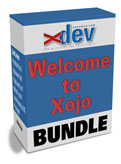Article Preview
Buy Now
REVIEW
Rondo
Issue: 4.3 (January/February 2006)
Author: Greg Fiumara
Article Description: No description available.
Article Length (in bytes): 3,869
Starting Page Number: 10
Article Number: 4306
Related Web Link(s):
http://www.fracturedsoftware.com/
Full text of article...
Musicians of all people know that good products hardly ever come with a small price tag. Yet, thanks to the power of REALbasic and the ingenuity of fracturedSoftware, a new MIDI handling program named Rondo may finally break this trend.
Although this is not a music magazine, it is worth noting how beautifully Rondo displays MIDI data. This review tested a MIDI file generated from a music notation program. Rondo very simply created each instrument in the musical score under a "piano keyboard." The color of the "notes" under each piano key corresponded with that specific instrument playing that specific note. For those entering the music field, Rondo's visualization may be an interesting way to learn to play popular songs on a piano.
Rondo's main interface finds itself using either a modified listbox or a completely custom canvas control in order to make the piano keyboard and notes. If a listbox is used, fracturedSoftware uses some intense graphic calls in order to draw all the notes without slowing the program down. REALbasic's graphic support, with either object element, makes this task simple for the developer. Again in either case, major customization and subclassing is used in order to make the control a success. One can scale the graphic sizes in the control. No matter at what size, scrolling through the list of notes of a full score for this two minute song was a breeze, much like scrolling though a normal text document. This says something for the way the developer works with the REALbasic code to call routines fast and interact with the processor.
They say imitation is the best form of flattery, and such is true for Rondo. It has a very Cocoa-like toolbar, implemented effortlessly using the built in toolbar object in REALbasic. Imitation comes into play with the audio control buttons and audio navigation in the toolbar, which look almost exactly as if from iTunes. Using these controls not only helps the end user become more accustomed with the new program easily, but makes the software much more pleasant to use. REALbasic makes implementing these controls very easy by drawing graphics in canvas controls.
Rondo is all about customizing how MIDI files will sound. As aforementioned, it is a good tool for someone learning how to play the piano. Rondo takes this learning one step forward. Without altering pitch, users can dramatically speed up or slow down a piece. REALbasic programmers know simply changing a variable in REALbasic's integrated NotePlayer control does such. In fact, much of what makes Rondo great is its ability to beautifully represent data pulled from the NotePlayer control. Simple concepts exploited with beautiful graphics and REALbasic ease is just another part of what makes Rondo great.
Musician or not, any programmer can be impressed with what is fracturedSoftware's Rondo. Its rigorous graphic demands and use of an often overlooked REALbasic control set it apart from others. With lesser headaches than what other languages would provide, fracturedSoftware introduces Rondo.
End of article.

































